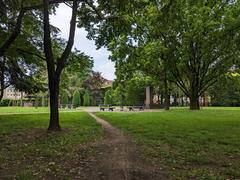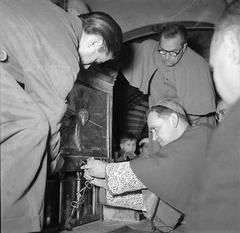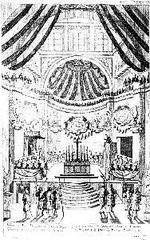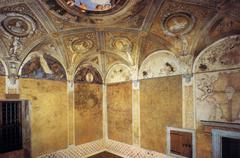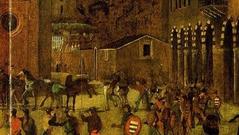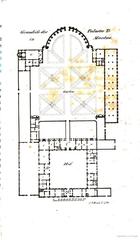Palazzo Acerbi Visiting Hours, Tickets, and Historical Guide – Mantua, Italy
Date: 04/07/2025
Introduction: Palazzo Acerbi’s Legacy in Mantua and Castel Goffredo
Palazzo Acerbi, also known as Palazzo Gonzaga-Acerbi, is a remarkable testament to the enduring legacy of Northern Italy’s architectural, political, and cultural evolution. Situated in Castel Goffredo and closely linked to Mantua’s UNESCO-listed historic center, the palace encapsulates centuries of transformation—from its medieval fortress roots, through the Renaissance era under the Gonzaga family, to its neoclassical revamp by the Acerbi lineage. As one of the region’s most intriguing historical sites, Palazzo Acerbi offers visitors an immersive journey through time, revealing stories of power, artistry, and resilience that have shaped the history and identity of Mantua and Castel Goffredo (Castel Goffredo Tourism, Mantua Tourism Official Site, Lombardia Beni Culturali).
Despite limited interior access due to private ownership and ongoing legal matters (notably regarding the Torre della Gabbia), the palace’s exterior, historical context, and location amid Mantua’s cultural landmarks remain captivating for visitors. This comprehensive guide provides essential information, including the palace’s history, architectural highlights, visitor logistics, practical travel tips, and recommendations for exploring nearby attractions.
Table of Contents
- Introduction
- Historical Overview
- Location and Urban Context
- Architectural and Artistic Highlights
- Visitor Information
- Combining Your Visit with Other Mantua Attractions
- Legal and Administrative Updates
- Frequently Asked Questions (FAQ)
- Conclusion and Final Tips
- References
Historical Overview
Origins and Early Development
Palazzo Acerbi’s origins trace back to the late 13th century, initially forming part of Castelvecchio’s fortified complex in Castel Goffredo. The structure began as two castellated buildings, later united by Bishop Ludovico Gonzaga’s renovations in the late 15th century. Architect Ermes Flavio de Bonis is credited with consolidating the buildings by 1499, laying the foundation for the palazzo’s evolution from fortress to stately residence.
Gonzaga Era: Renaissance Splendor and Political Power
The 16th century marked the palace’s golden age under the influential Gonzaga family. Marquis Aloisio Gonzaga established the palace as the center of his court, hosting eminent figures such as poet Pietro Aretino, writer Matteo Bandello, and Emperor Charles V (who visited in 1543). The transformation included the addition of an internal garden with ancient trees, a marble fountain, and a pergola, reflecting the sophistication of Renaissance court life (Wikipedia - Palazzo Gonzaga-Acerbi).
The Acerbi Family and Neoclassical Transformation
After the Gonzaga dynasty’s decline and subsequent Austrian control, the palace entered a new phase under Colonel Giacomo Acerbi in 1776. The Acerbi family modernized the building, removing medieval crenellations, enlarging windows, and bestowing it with neoclassical charm. The palace gained further historical significance as the birthplace of Giuseppe Acerbi (writer and archaeologist) and Giovanni Acerbi, a Risorgimento patriot who hosted Giuseppe Garibaldi in 1862. Commemorative plaques and the annual Giuseppe Acerbi Literary Prize keep the palace’s cultural legacy alive.
Location and Urban Context
Palazzo Acerbi stands prominently in both Castel Goffredo and Mantua’s urban fabric. In Mantua, it is found on Via Cavour, adjacent to the iconic Torre della Gabbia, a short walk from Piazza Sordello—the city’s political and social nucleus since medieval times. The palace is part of an architectural ensemble that includes Palazzo Ducale, Mantua’s Cathedral (Duomo), and other civic monuments, contributing to the unique skyline and urban dialogue of this UNESCO World Heritage site (Lombardia Beni Culturali, in-Lombardia).
Architectural and Artistic Highlights
Exterior Features and Torre della Gabbia
The palace’s main façade, constructed from local brick and stone, is defined by its robust masonry, Renaissance moldings, and a frieze of cherubs. The adjacent Torre della Gabbia, built in 1281, remains a striking medieval tower known for its iron cage once used for public punishment—a stark reminder of Mantua’s turbulent political past (Travel Connect Experience). The internal courtyard, although modified, retains traces of arcaded walkways and original stonework.
Interior Spaces and Decorative Elements
While interior access is rare, historical records reveal lavish apartments with frescoed grotesque faces, heraldic motifs, and wooden beams—often attributed to artists from Giulio Romano’s school. Surviving fragments of fresco cycles and ornamental stuccoes evoke the palace’s former artistic splendor. The internal garden remains a tranquil highlight, featuring century-old trees, a marble fountain, and a pergola.
Visitor Information
Opening Hours
- Castel Goffredo Location: Open Tuesday to Sunday, 9:00 AM – 6:00 PM (closed Mondays and public holidays). Hours may vary during special events; always confirm on the official tourism website.
- Mantua (Via Cavour) Location: As of July 2025, Palazzo Acerbi is a private residence and is not open for general public tours. Access is only possible during specific cultural events (e.g., FAI Spring Days) or by arrangement (Voce di Mantova).
Ticketing and Guided Tours
- General Admission: No regular tickets are sold for the Mantua palace; special event tickets must be booked in advance.
- Castel Goffredo: Adults €8, Reduced €5 (students, seniors), Children under 12 free. Group rates and guided tours available.
- Guided Tours: Daily at 10:00 AM and 3:00 PM in Castel Goffredo; advance booking is essential for Mantua special events.
- Torre della Gabbia: Access is suspended due to legal disputes.
Accessibility
- Castel Goffredo: Wheelchair accessible (ramps and elevators), with assistance available.
- Mantua Location: Accessibility is limited; exterior is accessible, but interiors may involve steps and uneven floors.
How to Get There
- By Train: Mantua station is well-connected; Castel Goffredo accessible via regional trains and local buses.
- By Bus: Local buses serve both Mantua (Via Cavour, Piazza Sordello) and Castel Goffredo.
- By Car: Parking available at Piazza Mazzini (Castel Goffredo) and outside Mantua’s ZTL zones.
Visitor Experience & Practical Tips
- Bring a camera for the ornate façade and garden.
- Visit in spring or autumn for the best weather and fewer crowds.
- Check official tourism sources for updates on special openings and events.
- Respect privacy—do not attempt to enter private areas.
Combining Your Visit with Other Mantua Attractions
- Palazzo Ducale: Open to the public with regular hours and ticketing (Tiqets).
- Basilica di Sant’Andrea: Renaissance masterpiece, free entry.
- Piazza Sordello: Main square surrounded by historic buildings.
- Castel Goffredo Civic Tower & Piazza Mazzini: Additional highlights in Castel Goffredo (ItalyScapes).
Legal and Administrative Updates
Due to ongoing disputes between Mantua’s administration and the Palazzo Acerbi-Cadenazzi condominium regarding access to the Torre della Gabbia, public entry to the tower remains suspended (Voce di Mantova). Always check the latest updates before your visit.
Frequently Asked Questions (FAQ)
Q: What are Palazzo Acerbi’s regular visiting hours?
A: Castel Goffredo location: Tuesday to Sunday, 9:00 AM – 6:00 PM. Mantua location: No regular hours; open during special events.
Q: Can I buy tickets to visit Palazzo Acerbi?
A: Tickets are available for Castel Goffredo; Mantua location only during special openings.
Q: Is photography allowed?
A: Exterior photography is permitted. Interior photography is allowed only during authorized events.
Q: Is Palazzo Acerbi wheelchair accessible?
A: Accessibility is good in Castel Goffredo; limited in the Mantua location, mainly for the exterior.
Q: How do I find out about special tours?
A: Monitor the Mantua tourism website and local cultural associations for announcements.
Conclusion and Final Tips
Palazzo Acerbi is an essential stop for anyone exploring Mantua or Castel Goffredo’s historical sites. Its architectural beauty, layered history, and connection to influential families like the Gonzaga and Acerbi make it a profound symbol of Lombardy’s cultural heritage. Despite limited public access, the palace’s façade, adjacent Torre della Gabbia, and position within Mantua’s historic core make it well worth including in any itinerary.
Enhance your visit by integrating Palazzo Acerbi into a broader exploration of Mantua’s landmarks, staying up to date on special events via official tourism channels, and utilizing resources like the Audiala app for immersive guides. By respecting the palace’s private status and appreciating its urban context, travelers can engage deeply with Mantua’s extraordinary past.
Download the Audiala app for the latest updates, guided tours, and travel tips. Follow us on social media for real-time news and exclusive content about Italy’s architectural treasures!
Visual Resources
References
- This is a sample text. (Castel Goffredo Tourism)
- This is a sample text. (Mantua Tourism Official Site)
- This is a sample text. (Lombardia Beni Culturali)
- This is a sample text. (Wikipedia - Palazzo Gonzaga-Acerbi)
- This is a sample text. (ItalyScapes)
- This is a sample text. (Travel Connect Experience)
- This is a sample text. (Voce di Mantova)
- This is a sample text. (Tiqets)
- This is a sample text. (in-Lombardia)
For further reading, explore:
- Exploring Palazzo Ducale: Mantua’s Grand Ducal Palace
- Top 10 Historical Sites to Visit in Mantua
- Mantua Food Guide: Where to Enjoy Local Specialties

